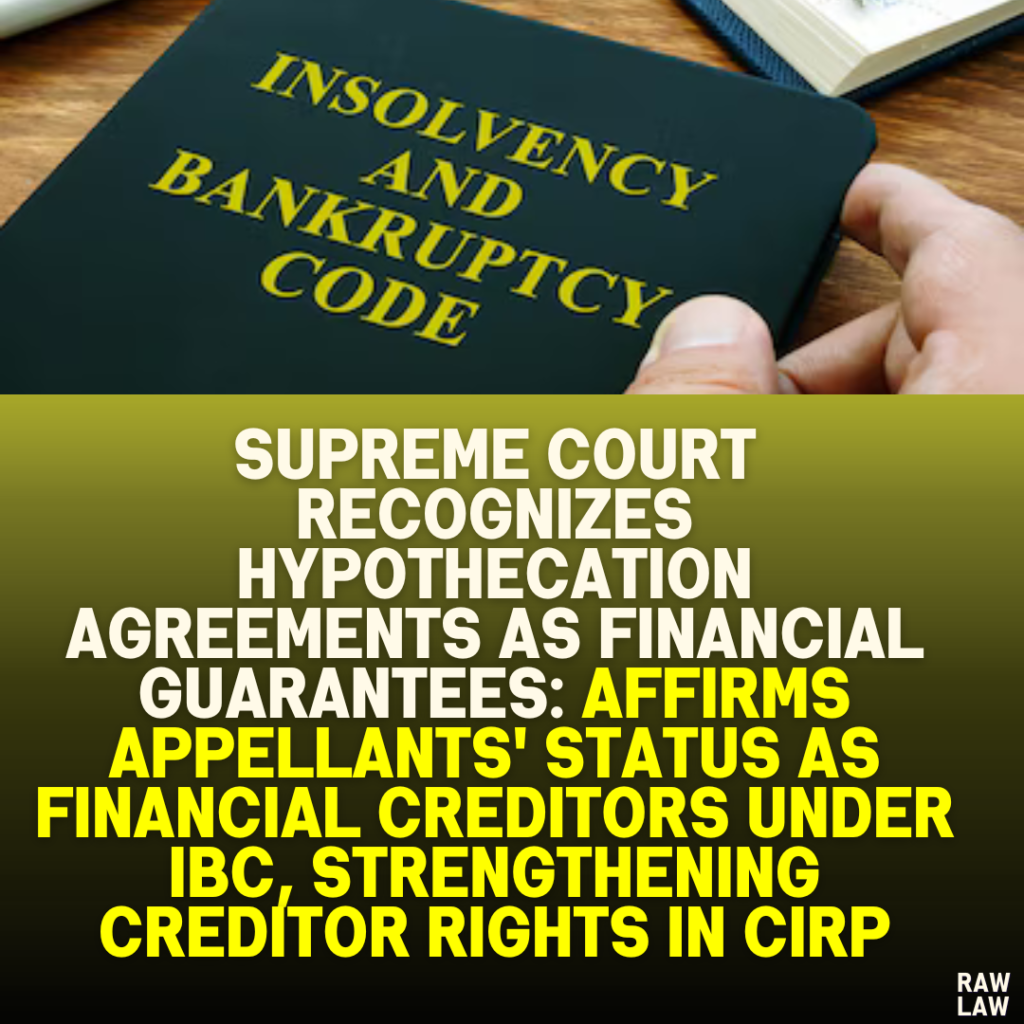Court’s Decision
The Supreme Court overturned the National Company Law Appellate Tribunal (NCLAT) ruling, recognizing the appellants as financial creditors under the Insolvency and Bankruptcy Code, 2016 (IBC). It held that the Deeds of Hypothecation (DoH), executed by the Corporate Debtor, constituted a financial guarantee for the debts of other Reliance Communications (RCom) entities. Consequently, the appellants were eligible to participate as financial creditors in the Corporate Insolvency Resolution Process (CIRP).
Facts
- Background:
- The Corporate Debtor was part of a group of companies (RCom entities), which included Reliance Communications Ltd. (RCom), Reliance Telecom Ltd. (RTL), and Reliance Infratel Ltd. (RITL).
- Public announcements were made inviting claims from creditors after CIRP was initiated for the Corporate Debtor.
- The appellants, financial institutions including the China Development Bank, submitted claims as financial creditors based on the security arrangements under the Deeds of Hypothecation and Master Security Trustee Agreement (MSTA).
- The Dispute:
- Doha Bank, a competing creditor, challenged the status of the appellants as financial creditors.
- The appellants argued that the DoH imposed obligations on the Corporate Debtor to make good any shortfall in the repayment of loans availed by RCom and RTL, constituting a financial guarantee.
- Lower Court Rulings:
- The National Company Law Tribunal (NCLT) upheld the appellants’ status as financial creditors.
- The NCLAT reversed the NCLT decision, holding that the DoH was merely a security document and did not establish a financial guarantee.
Issues
- Primary Issue: Can the appellants be classified as financial creditors under the IBC?
- Secondary Issue: Does the obligation under Clause 5(iii) of the DoH constitute a financial guarantee?
Petitioner’s Arguments
- Nature of Obligations under the DoH:
- Clause 5(iii) of the DoH explicitly required the Corporate Debtor to cover any shortfalls in the recovery of loans after the sale of hypothecated assets.
- This obligation met the definition of a contract of guarantee under Section 126 of the Indian Contract Act, 1872.
- Definition of Financial Debt:
- Under Section 5(8) of the IBC, a financial guarantee qualifies as financial debt. The appellants argued that the Corporate Debtor’s obligations under the DoH satisfied this criterion.
- Rights as Financial Creditors:
- The appellants participated in the CIRP as financial creditors and voted on the Resolution Plan. Their exclusion as financial creditors at a later stage would disrupt the CIRP process.
Respondent’s Arguments
- Standard Nature of DoH:
- Doha Bank argued that the DoH was a standard hypothecation agreement that did not involve any guarantee obligations.
- The clause requiring the Corporate Debtor to pay shortfalls was contingent and could not create a direct financial obligation.
- Moratorium under IBC:
- Section 14 of the IBC imposes a moratorium during CIRP, preventing the sale of hypothecated assets. Therefore, no shortfall could arise, making the guarantee clause inoperative.
- No Direct Lending:
- The appellants had no direct lending relationship with the Corporate Debtor, as the loans were provided to RCom and RTL. The Corporate Debtor was only a hypothecator, not a guarantor.
Analysis of the Law
- Definition of Financial Debt (IBC Section 5(8)):
- Financial debt includes any liability arising from guarantees for loans disbursed to third parties. The Supreme Court observed that the Corporate Debtor’s commitment to cover shortfalls was equivalent to a guarantee, qualifying it as financial debt.
- Guarantee under the Indian Contract Act (Section 126):
- A guarantee involves a promise to discharge the liability of a third party in case of default. The Court held that Clause 5(iii) of the DoH fulfilled this requirement, as the Corporate Debtor committed to cover any shortfall in loan repayment by RCom or RTL.
- Enforceability of Claims:
- The Court clarified that the moratorium under Section 14 of the IBC only prohibits enforcement actions but does not extinguish the underlying financial claims.
- Precedents Cited:
- Kotak Mahindra Bank v. Balakrishnan: A financial debt can arise without direct disbursement to the Corporate Debtor.
- Phoenix ARC v. Ketulbhai Patel: Distinguished, as no guarantee obligation was created in that case.
Precedent Analysis
The Court emphasized:
- The expansive definition of financial debt under the IBC to include obligations arising from guarantees.
- The need to evaluate the substance of contractual obligations rather than the nomenclature of documents.
Court’s Reasoning
- Interpretation of the DoH:
- The Corporate Debtor hypothecated its assets to secure loans availed by RCom and RTL.
- Clause 5(iii) obligated the Corporate Debtor to pay any shortfall in loan recovery after the sale of hypothecated assets, amounting to a financial guarantee.
- Nature of the Obligation:
- The Court held that the guarantee obligation was independent of the enforcement of hypothecated securities and was not contingent on the sale of assets.
- Participation in CIRP:
- The appellants participated as financial creditors in the CIRP. Their exclusion would undermine the Resolution Plan approved by the Committee of Creditors (CoC).
Conclusion
The Supreme Court held that the appellants were financial creditors under the IBC. It directed the adjudicating authorities to recognize their claims and include them in the distribution under the Resolution Plan.
Implications
- This ruling affirms that obligations under hypothecation agreements can create financial guarantees if they involve an undertaking to discharge third-party liabilities.
- It reinforces the expansive interpretation of financial debt, strengthening creditors’ rights in insolvency proceedings.
- The judgment ensures procedural integrity in CIRP by recognizing creditors who actively participate in the resolution process.



